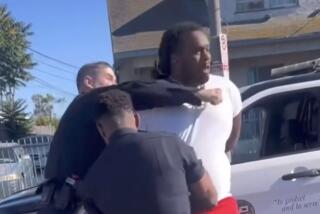Tape of Beating Brings Tips on Reacting to Police
- Share via
In the days after the videotaped police beating of a 16-year-old boy in Inglewood, community activists in Compton and other largely minority communities devised a project that they hope will help avoid further violent confrontations during traffic stops.
Working with the Los Angeles County sheriff’s deputies who patrol Compton, a coalition of civic and religious leaders put together a detailed pamphlet that advises motorists on ways to keep things calm and cool when they are pulled over by officers.
“Lots of citizens have anger, fear and trepidation about the police, and they don’t realize they can make a difference” in the outcome of an encounter with officers, physician James Mays said Saturday at a forum to introduce the pamphlet.
Mays and other leaders said they are not trying to let heavy-handed police officers off the hook. They said they want to help prevent an otherwise “good” stop from going bad by educating residents about their responsibilities.
“We hope this will bring about healing,” said another forum organizer, the Rev. Lowe Barry.
The project grew out of the incident in Inglewood last month, when a police officer slammed a handcuffed Donovan Jackson, 16, onto a patrol car and punched him in the face. Officers had been questioning Jackson’s father about expired license tags. A bystander caught much of the incident on videotape, and it has sparked outrage in Southern California and around the nation.
Two Inglewood officers have been suspended and face trial, one on an assault charge, the other on a charge of filing a false police report.
Sheriff’s Capt. Cecil Rhambo, commander of the Compton station, said he was happy to help with the project that community leaders proposed.
“Law enforcement spends a great deal of time training officers.... We felt there needed to be something that gives citizens something of the perspective of a law officer,” he said.
But Rhambo, who grew up in South-Central Los Angeles and is well acquainted with some minority group members’ experiences with police, was quick to add that he did not mean to imply motorists were solely at fault.
“There are a lot of factors that go into” how a traffic stop progresses, he said, and “everyone involved has some responsibility” to see that cool heads prevail.
With a volunteer “subject” behind the wheel of a white sport utility vehicle, deputies made two simulated stops to show how a motorist’s demeanor could make a difference.
Mays said leaders devised the pamphlet after their research showed that there were few resources for parents who want to teach their teenage children how to avoid trouble if they are pulled over. It is designed to be a “common-sense teaching and discussion” tool for families, he said.
Mays also said he hopes that the education project will be emulated throughout California and in other major cities.
He wants to highlight it in another community forum, with the Los Angeles Police Department, in about two weeks.
The “Citizens/Law Enforcement Encounter/Detention Information Pamphlet” lists responsibilities of citizens and law enforcement officers, and includes instructions on what to do if stopped and how to handle the situation if a motorist is unhappy with the way the encounter went.
Among the suggestions for motorists:
“Calmly obey officer’s instructions or demands.
“Keep hands visible at all times.
“Do not reach for documents or objects (such as cell phone) without instructions or permission from the officer.
“Realize that the officer is the authority with the legal and lethal force.”
The pamphlet also urges motorists to be polite and cooperative and to get the officer’s name or to calmly request the presence of a supervisor if things seem to be getting out of hand.
Patricia Corona, a mother of three teenagers, said she was grateful for the advice and would use the pamphlet in a family discussion.
“I think this will be helpful to my children,” she said. “We really need more things like this, because the community and the police have to be working together and helping each other.”
More to Read
Sign up for Essential California
The most important California stories and recommendations in your inbox every morning.
You may occasionally receive promotional content from the Los Angeles Times.














